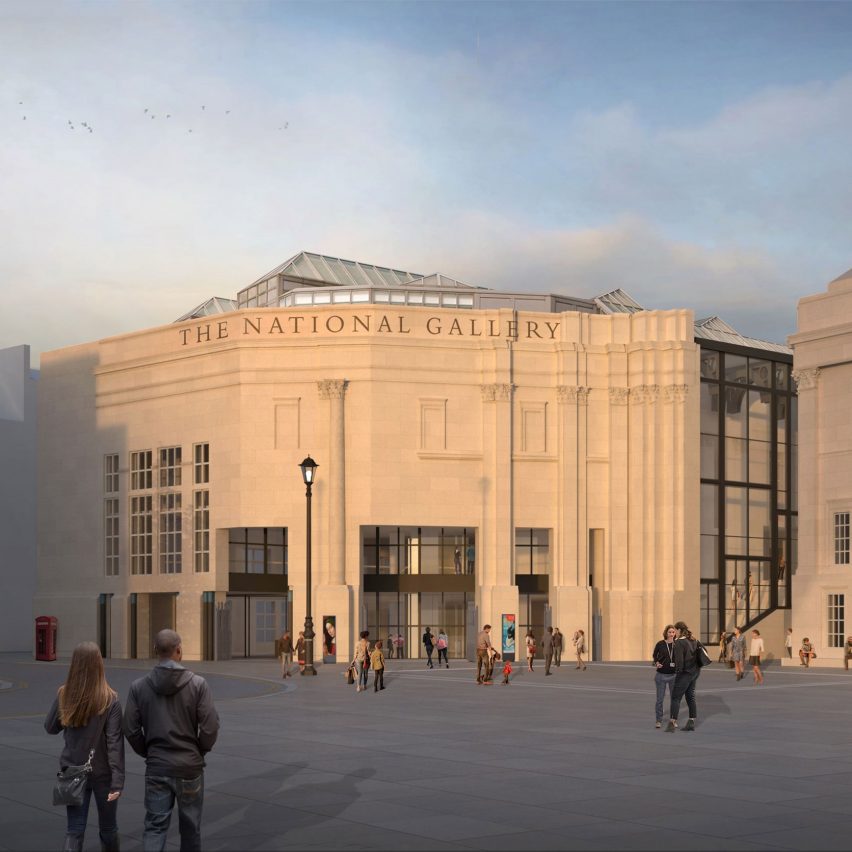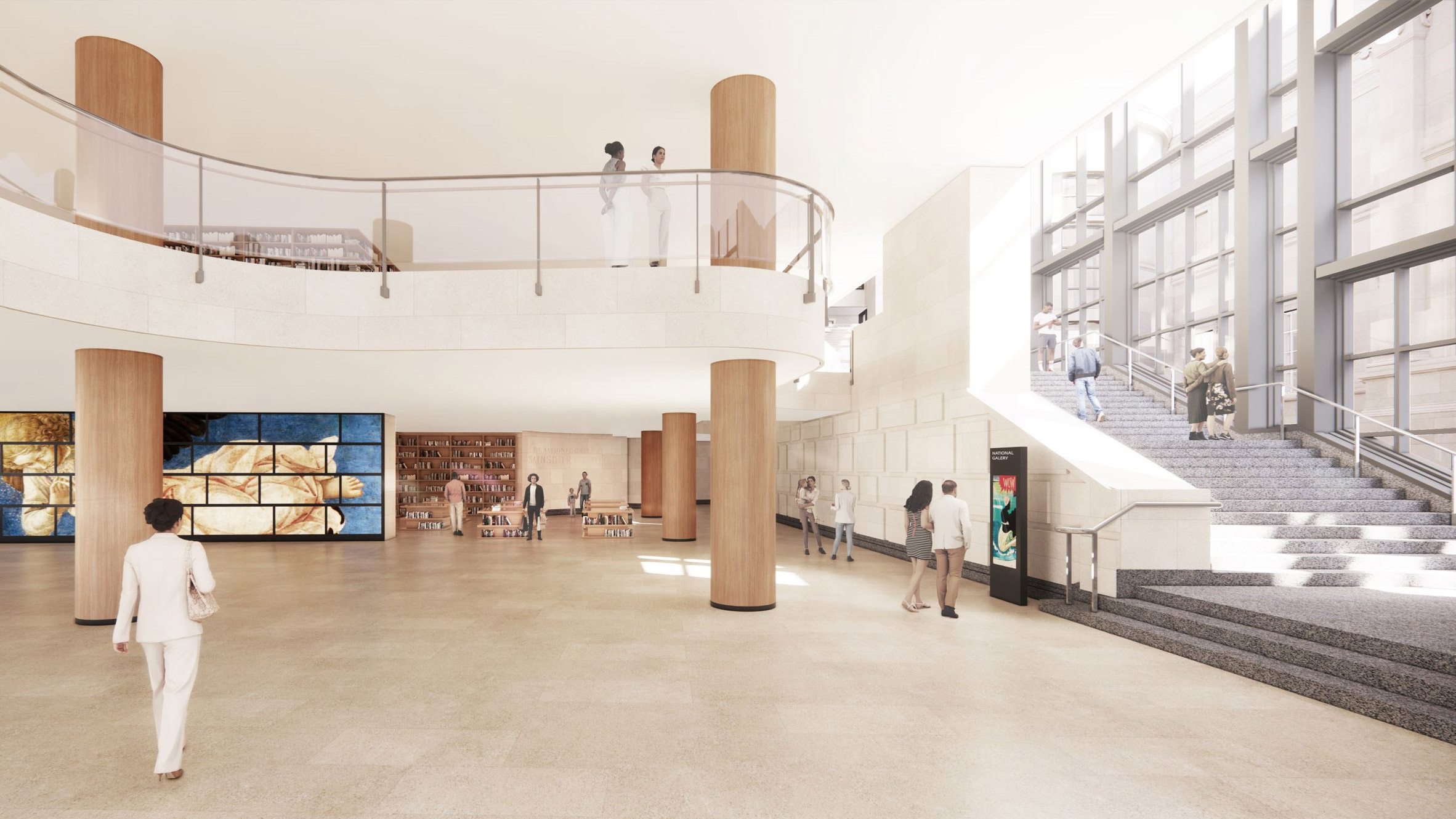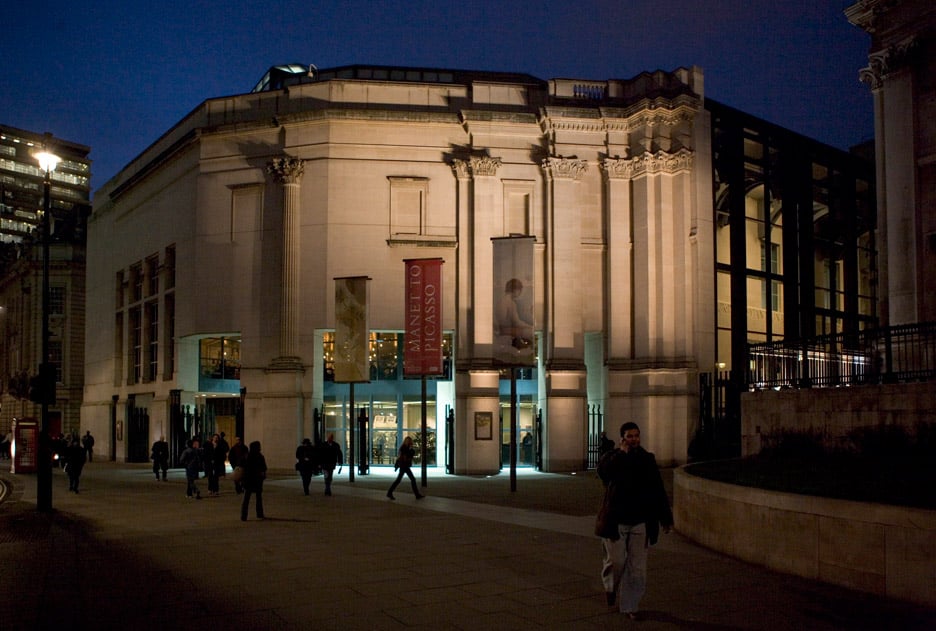
Architects, critics and academics are concerned about Selldorf Architects‘ plans to remodel Robert Venturi and Denise Scott Brown‘s postmodern Sainsbury Wing at the National Gallery in London.
Plans to overhaul Venturi, Scott Brown’s extension to the National Gallery in central London have been described by detractors as “damagingly destructive”, “an act of vandalism” and a “tepid shower of the pallid and the polite”.
“These proposed alterations would be damagingly destructive – sterilising the original architectural character of the building,” architectural critic Hugh Pearman told Dezeen.
“Museums need to be able to adapt to changing needs over time of course, and the proposed scheme is not only about aesthetics, but in the context of the unique character of this building, the deployment of ubiquitous corporate, airport concourse aesthetics in the proposed revamp looks a lot like an act of vandalism to me,” architect and professor of architecture at the University of Westminster Sean Griffiths told Dezeen.
Alterations “will diminish the intended drama of the carefully orchestrated entrance route”
Selldorf Architects‘ plans, which are due to be decided on this autumn, would see the Sainsbury Wing’s facade updated with its dark glass replaced with transparent panes and the lobby largely remodelled, with ceilings and original columns removed.
“The entrance hall is influenced by the low-slung ceilings and heavy articulated columns of Aalto buildings – imagine the furore if something like this was being done to the Finlandia Hall – this is the UK equivalent,” continued Griffiths.

Architectural charity Twentieth Century Society criticised the proposed alterations to the entrance lobby as it says they would damage the original architects’ intention for the space.
“We strongly oppose the removal of the original rusticated columns in the ground floor lobby – which could and should be retained in any new scheme – and the opening up of this space by removing large parts of the floorplate, which will diminish the intended drama of the carefully orchestrated entrance route,” said Twentieth Century Society director Catherine Croft.
University of Zurich professor Stanislaus von Moos, who wrote a monograph on the work of Venturi, Scott Brown, echoed the view that the lobby alterations would damage the building’s overall concept.
“You can’t take out a part without making the entire organism fall into pieces,” he told Dezeen.
“Selldorf Architects propose to neutralize the entrance situation by turning it into a brightly lit double-height showroom, thereby pulling the rug under the building’s processional logic.”
Building “most elegant demonstration of Venturi and Scott Brown’s ideas”
Selldorf Architects was selected to overhaul the building in collaboration with heritage specialists Purcell in 2021 and its proposals have been subject to two public consultations. The gallery is now waiting for its planning application to be approved or declined.
Opened in 1991, the building designed by Venturi and Scott Brown is one of the UK’s best-known postmodern buildings and one of the architects’ most influential works.
“The Sainsbury Wing is the clearest, most elegantly and joyfully whole demonstration of Venturi and Scott Brown’s ideas,” explained Drexel University professor and former VSBA principal Nancy Rogo Trainer.
“The proposed alteration would radically and irrevocably change the meaning and experience of the Sainsbury Wing at a particularly vulnerable time in its history – too old to be considered contemporary and too recent to be viewed as historic,” she told Dezeen.
“Surely there is a more sensitive, less fundamentally destructive way to improve the experience of visitors to the National Gallery.”
Renovation appears to be “corporate blandness”
Architectural historian Gillian Darley, who criticised the lobby space in a review for the Observer newspaper when the building opened, also took aim at the “blandness” of the proposed renovation.
“If I gave the entrance foyer a thumbs down then as ‘a nasty cellar-like space’ I can be allowed, nay forced, a rethink faced with the flimsy, corporate blandness on offer thirty years on,” she told Dezeen.
“The muscular dark-into-light has been replaced with what the CGIs show as a tepid shower of the pallid and the polite, seemingly offered without thought or reciprocity towards the existing – no thanks.”
The plan to revamp the building form part of the gallery’s NG200 project to mark its bicentenary in 2024. The renovation will see an espresso bar added to the building’s ground floor and a cafe on its first floor, as well as a seminar room, archival store and staff offices added.
“We have taken on board the views of the various groups and are reviewing certain elements of the scheme in the light of their comments,” said a spokesperson for the National Gallery.
“We will continue to have ongoing dialogue with a number of key stakeholders to achieve a solution that balances our respect for the existing building with our need to create a National Gallery that appeals and can adapt to a more diverse audience.”
“This impacts on all the best buildings we have”
Occupying a prominent location on London’s Trafalgar Square alongside the gallery’s original 19th-century building designed by William Wilkins, the Sainsbury Wing extension was Grade I-listed in 2018.
Grade I-listed buildings are deemed to be “of exceptional interest” with only 2.5 per cent of all listed buildings given this level of protection.
The Sainsbury Wing is one of the most recent buildings to be Grade I-listed, and critic Pearman questioned the validity of the system if large-scale alterations are permitted.
“There is a general issue at stake here, and this impacts on all the best buildings we have – if a Grade I-listed building can be knocked about in this way, then what does the listing system mean?” he asked. “
“Does it offer any real protection at all?” he continued. “In my view, it should be the duty of the planning authorities to refuse this application on those grounds alone.”

The Twentieth Century Society also asked whether alterations of this scope would be permitted to some of the more historic buildings that are Grade I-listed.
“It’s amongst the most historically and architecturally significant buildings in England constructed in the past 40 years,” said Croft.
“We want future generations to be able to visit the National Gallery and see a world-class work of postmodern architecture, as well as a stunning collection of international art,” she continued. “It’s hard to imagine any Grade I-listed building of an earlier period – let alone that of a national institution – being subjected to such treatment.”
“It’s loved and loathed in equal measures”
The Sainsbury Wing has a controversial history. The Venturi Scott Brown building was the winner of the second competition for the site after the initial contest was abandoned following an intervention by King Charles III.
King Charles III, who was then Prince Charles, infamously called the original winning design by Ahrends, Burton, and Koralek a “monstrous carbuncle”.
“It’s loved and loathed in equal measures but that’s what’s brilliant about it,” said Griffiths. “Whether you love it or hate it, it’s a totally unique building, unlike any other in the UK or the world.”
“It has been stimulating heated debate about architecture in the UK for the whole of its existence, from the time the 1990s when only we at FAT and a handful of others appreciated it, to the present when the reputations of Denise Scott Brown and Robert Venturi have correctly been rehabilitated,” he continued.
Despite its controversial history, the building is seen as a significant work of postmodern architecture with the American Institute of Architects bestowing its 25 Year Award upon the building in 2019.
The images are courtesy of Selldorf Architects, unless otherwise stated.
The post Revamp of Venturi Scott Brown's National Gallery extension would be "an act of vandalism" appeared first on Dezeen.
